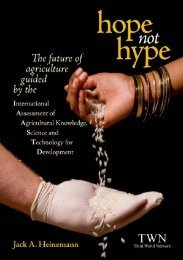gene Flow: Implications for Crop Diversity and Wild Relatives
gene Flow: Implications for Crop Diversity and Wild Relatives
gene Flow: Implications for Crop Diversity and Wild Relatives
- No tags were found...
You also want an ePaper? Increase the reach of your titles
YUMPU automatically turns print PDFs into web optimized ePapers that Google loves.
Ellstr<strong>and</strong>, N. C. (2001). “<strong>Crop</strong> trans<strong>gene</strong>s in natural populations.”Abstracts of Papers American Chemical Society 221(1-2): AGFD37.Ellstr<strong>and</strong>, N. C. <strong>and</strong> C. A. Hoffman (1990). “Hybridization as anAvenue of Escape <strong>for</strong> Engineered Genes Strategies <strong>for</strong> RiskReduction.” Bioscience 40(6): 438-442.Ellstr<strong>and</strong>, N. C., H. C. Prentice, et al. (1999). “Gene flow <strong>and</strong>introgression from domesticated plants into their wild relatives.”4139 El Camino Way, Palo Alto, CA, 94303-0139, USA, AnnualReviews.Ellstr<strong>and</strong>, N. C. <strong>and</strong> K. A. Schierenbeck (2000). “Hybridization as astimulus <strong>for</strong> the evolution of invasiveness in plants?” Proceedingsof the National Academy of Sciences of the United States ofAmerica 97(13): 7043-7050.Friesen, L., A. Nelson, et al. (2003). “Evidence of contamination ofpedigreed canola (Brassica Napus) Seedlots in Western Canadawith <strong>gene</strong>tically engineered herbicide resistant traits.” AgronomyJournal 95: 1342-1347.Garcia, M., J. Figueroa, et al. (1998). “Pollen control during transgenichybrid maize development in Mexico.” <strong>Crop</strong> Science 38(6): 1597-1602.Gepts, P. (1993). “The use of molecular <strong>and</strong> biochemical markers incrop evolution studies.” Evolutionary Biology 27: 51-94.Gepts, P. <strong>and</strong> R. Papa (2003). “Possible effects of (trans)<strong>gene</strong> flowfrom crops on the <strong>gene</strong>tic diversity from l<strong>and</strong>races <strong>and</strong> wildrelatives.” Environmental Safety Research 2: 89-103.Gueritaine, G., M. Sester, et al. (2002). “Fitness components ofprogeny of hybrids between transgenic oilseed rape (Brassicanapus) <strong>and</strong> wild radish (Raphanus raphanistrum).” MolecularEcology 11: 1419-1426.Hall, L., K. Topinka, et al. (2000). “Pollen flow between herbicideresistantBrassica napus is the cause of multiple-resistant B.napus volunteers.” Weed Science 48(6): 688-694.Harremoes, P., D. Gee, et al., Eds. (2002). Late lessons from earlywarnings: the precautionary principle 1896-2000. Luxembourg,European Environment Agency.28
















